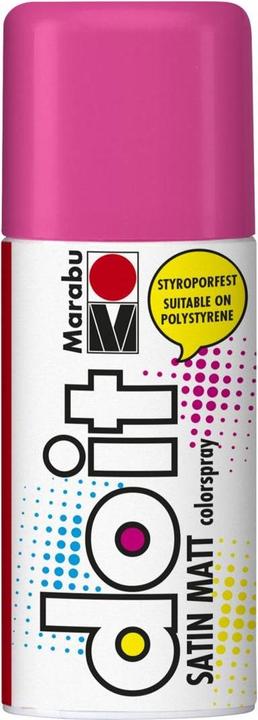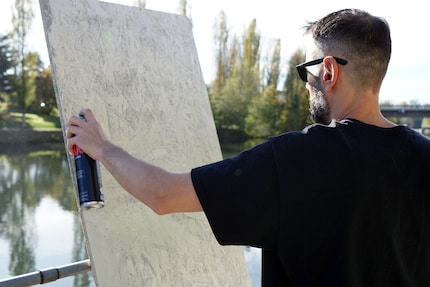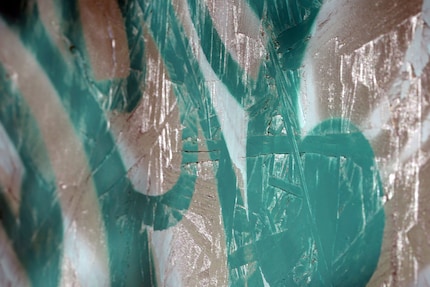
Marabu Spray paint do it Satin matt
Crimson, 150 ml
Montana Cans are considered the de facto standard spray cans among graffiti artists. They are reliable, apply colour to the surface and cost little. Marabou cans are now for sale in the Galaxus shop. We grabbed a graffiti artist and put Marabu Cans in his hand.
"Wood is a very special material," says the native Spaniard in broken German. As it is alive and has pores, it has to be treated very carefully. "There are woods that simply soak up all the colour and in the end your work is washed out and lame," he says. Unlike with a concrete wall, a sprayer has to be able to fully rely on the colours in his hand. The balance between paint and pigment is crucial here, says Mazo.
Mazo takes orders. Video producer Linus Konetschnig takes advantage of this. He happens to know that Mazo got his start with Marabu cans. In 1989, the Spaniard and his crew made his home village less colourful with a few cans. "He could test the Marabu Cans for us," he says at the meeting.
According to the manufacturer, the cans are called "Marabu Do It Satin Matt" and are good for wood, among other things. One visit to the DIY store and one order later, Linus is on his way to Mazo's studio, also known as the riverside, with a man-sized sheet of chipboard.
Warm-up exercises. Before Mazo takes on the whole panel, he quickly sketches a face. "I want to quickly see what the wood thinks about colour," he says. He looks at the panel with the portrait, nods and takes the primer from the corner. Not a marabou can, but one of his own colours.
"Matt silver," he realises, "If I'm going to have matt marabou, I don't want the base to glow."
It's serious. Mazo is in his element. Before he sprays a single drop of paint onto the chipboard, he shakes the marabou well and sprays a small dot onto a second base surface.
"Before I start, I need to know that the colours are well mixed."
Linus prepares his camera. The shoot can begin.
The sprayer is at work, the cameraman is on it. Linus notices that Mazo's face is darkening. Sometimes, it seems, Mazo tries not to swear.
"Look at that! The wood is soaking up so much paint," he says.
He continues to work, mumbling something to himself every now and then. Linus doesn't understand Spanish and Mazo obviously doesn't need any explanation. He doesn't have to, because the structure of the chipboard shines through the colour. There's no question of saturation. Mazo would prefer to quickly leave the marabou in place and touch up the worst stains with Montana Cans.
Linus asks what the problem is.
"I'm not sure. Either the Marabus were stronger back then or I'm used to the luxury of the much stronger Montana Cans," says Mazo. He is visibly dissatisfied with his work. Later, Linus' editorial colleagues will say that the wooden structure actually looks quite cool under the graffiti. Mazo doesn't care much about that. He wants opaque, bright, gaudy colours.
He changes the technique, because the rules of the test are clear: marabou cans only. Brushing, filling, shading... Mazo is on the job with fire. He draws a sobering conclusion.
"Except for shading, I wouldn't recommend the cans," he says. This is precisely where the cans benefit from the fact that they have fewer colour pigments than other graffiti spray cans. They make it much easier to create a light veil of colour than cans that spray with high coverage and bright colours.
Disillusioned: Mazo doesn't like his work on woodHowever, even if they are not enough for the professional, there are still people who will enjoy the current generation of Marabu Cans. "If spraying is your hobby or you want to use them for DIY work, then go for it," he says.
Journalist. Author. Hacker. A storyteller searching for boundaries, secrets and taboos – putting the world to paper. Not because I can but because I can’t not.
Ivan Copete Escobar is known in graffiti circles as Mazo. His fan base comes from all over Europe and he mainly earns his money by spraying paint on walls, canvases and wood. He sells his works and makes a living from them. For the most part. An artist's life, but a life nonetheless. The sprayer, who has been working with spray cans for 30 years, earns some extra money by helping out in old people's homes.

Marabu Spray paint do it Satin matt
Crimson, 150 ml

Marabu Do It
Black, 150 ml

Marabu Spray paint do it Satin matt
Fuchsia, 150 ml

Marabu Spray paint do it Satin matt
Pastel blue, 150 ml

Marabu Spray paint do it Satin matt
Turquoise, 150 ml



